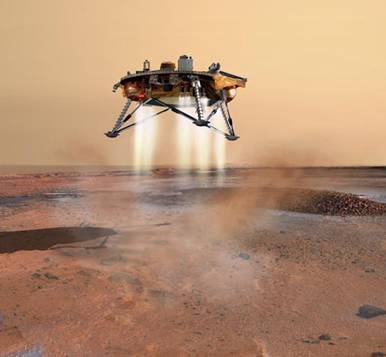27 May 2008

An artist’s rendition of the Phoenix Landing in the Martian North Polar Region
Credit: NASA/JPL-Caltech/University of Arizona
On 25 May 2008, NASA's Phoenix spacecraft touched down safely in the northern polar region of Mars, beginning a 3-months mission of exploring a site targeted for its likelihood of having frozen water within reach of the spacecraft's robotic arm.
Radio signals received shortly after the landing confirmed the Phoenix Mars Lander had endured its difficult Martian atmospheric descent, and touchdown 15 minutes earlier. The signals took that period to traverse the Earth-Mars distance, at the speed of light.
The Phoenix Mission team at NASA's Jet Propulsion Laboratory, Pasadena, California; Lockheed Martin Space Systems, Denver; and the University of Arizona, Tucson, cheered the successful landing and eagerly awaited further information from Phoenix.
NASA Administrator Michael Griffin observed the landing in the JPL control room. Dr Griffin noted this was the first successful Mars landing without airbags since the Viking 2 spacecraft in 1976.
“For the first time in 32 years, and only the third time in history, a JPL team has carried out a soft landing on Mars," Griffin said. "I couldn't be happier to be here to witness this incredible achievement."
During its nearly 675-million-km cruise from Earth to Mars, Phoenix relied on electricity from solar panels during the spacecraft's cruise stage. The cruise stage was jettisoned seven minutes before the lander, encased in a protective shell, entered the Martian atmosphere. Batteries provide electricity till deploying the lander's own pair of solar arrays.
"We've passed the hardest part and we're breathing again, but we still need to see that Phoenix has opened its solar arrays and begun generating power," said Barry Goldstein, Phoenix project manager (JPL).
Phoenix was launched on 4 August 2007, aboard a Delta II 7925 rocket from Cape Canaveral Air Force Station, Florida. Its journey to Mars lasted 10 months.
Further Reading
Phoenix Mars Lander
http://www.nasa.gov/mission_pages/phoenix/news/phoenix-20080525b.html
Aymen Mohamed Ibrahem
Senior Astronomy Specialist